Maximizing the Middle: Why Focusing Your Sales Talent Investment on Mid-Level Performers Will Exponentially Increase Sales Performance
While popular business media and culture tends to focus on sales leadership,
there is perhaps the greatest un-mined revenue generating opportunity lying
dormant within almost every sales organization in the world: mid-level sales
professionals. There’s no doubt that it’s more sexy and fun to be putting
together programs and working with people who are already members of the
presidents circle or high potentials, but at the end of the day it’s your
middle who are doing the bulk of the work. It is also in the “middle” where
the greatest development ROI and company performance gains can be derived. A
5% increase from a company’s middle performance yields 70% more revenue than a
5% performance increase of a company’s top 20% (Sales Executive Council,
2003).
In this work, an overview of what defines the middle, why it is imperative
that sales organizations focus on maximizing their middle, and ways to
leverage the potential of this sales employee population are presented.
What is the Middle?
As defined in this document, the middle is composed of three employee segments
within the sales organization: mid-level Sales Reps (M1), mid-level performers
(M2), and employees with mid-level competencies (M3).
M1 – Mid-level Sales Reps, exist between senior executives and sales
associates. At a broad level within the sales organization structure you have
senior Sales Reps, Mid-level Sales Reps, front-line associates. Mid-level
Sales Reps are an often-overlooked population that comprises a great source of
untapped sales revenue, future leaders, and opportunity for Increased employee
engagement.
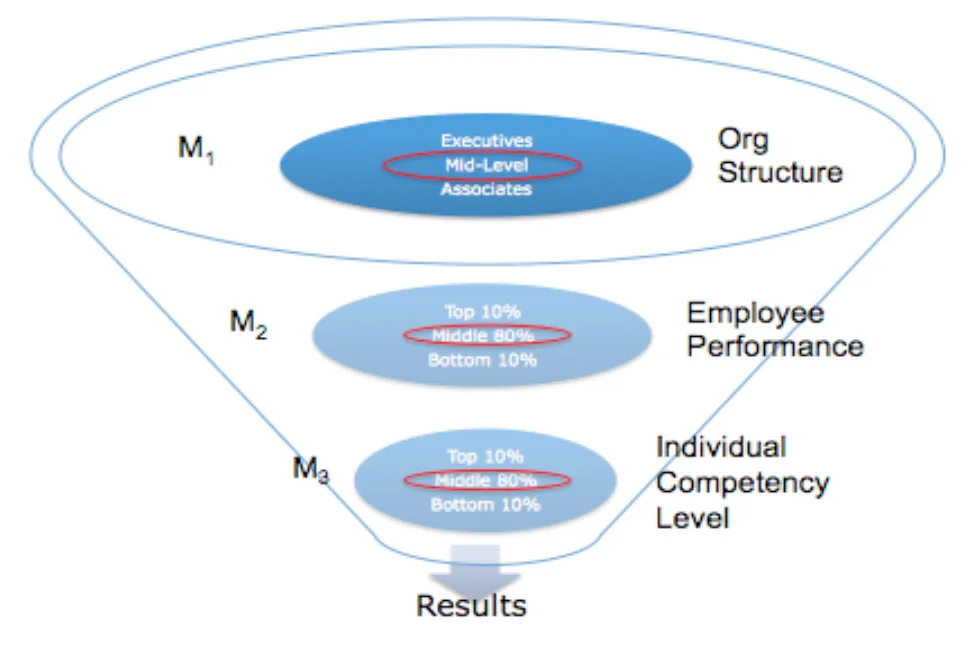
M2 - Mid-level performers; in every sales organization, there are a small
percentage of top performers, a small percentage of poor performers, and a
dominant percentage of mid-level performers. It is here in this mid-level
where the opportunity for greater sales performance lies.
M3 - employees with mid-level competencies. Similar to the performance
distribution curve of M2, there is a parallel curve of individual competency
level. This curve consists of a small percentage of individuals who are
experts and highly skilled (the go-to people), a small percentage of people
with lower levels of competency, and a dominant percentage of people with
adequate competency levels. It is here in the mid-range where increasing
competency levels by even a small amount can have large impact.
Combined, the sums of these “middles” are mid-level, mid-performing Sales
Reps, with mid-level competencies. Although this may not be as sexy as
developing your sales executive suite or focusing on your high-potentials, it
is through developing this core population of sales employees that will garner
great results.
Why Focus on the Middle?
There are number of reasons to focus your resources on this middle population.
From succession planning, to ensuring alignment between company strategy, and
execution of that strategy, the middle is vital to company success.
1. The Link Between Sales Strategy and Execution
The middle are the ones who translate and transform the sales strategy into
action and results.
2. They are the face of the company
The middle make up the majority of what your customers experience and perceive
from your company. From the first contact through the sales cycle, the ability
of your sales middle to connect, represent the company, communicate, and
partner with the customer is a vital. The middle also functions as the eyes
and ears of the company, acting as a liaison between the customer experience
and various functions within the company.
3. Compromise Bulk of Leadership Potential
An additional reason why companies should be focusing on this population is
that they make up the bulk of the current and future sales leadership
potential. This group, although outside the annual top 10% of top performers,
is where a large portion your talent resides.
the “middle” where the greatest development ROI and company performance gains
can be derived. A 5% increase from a company’s middle performance yields 70%
more revenue than a 5% performance increase of a company’s top 20%.
Shortcomings
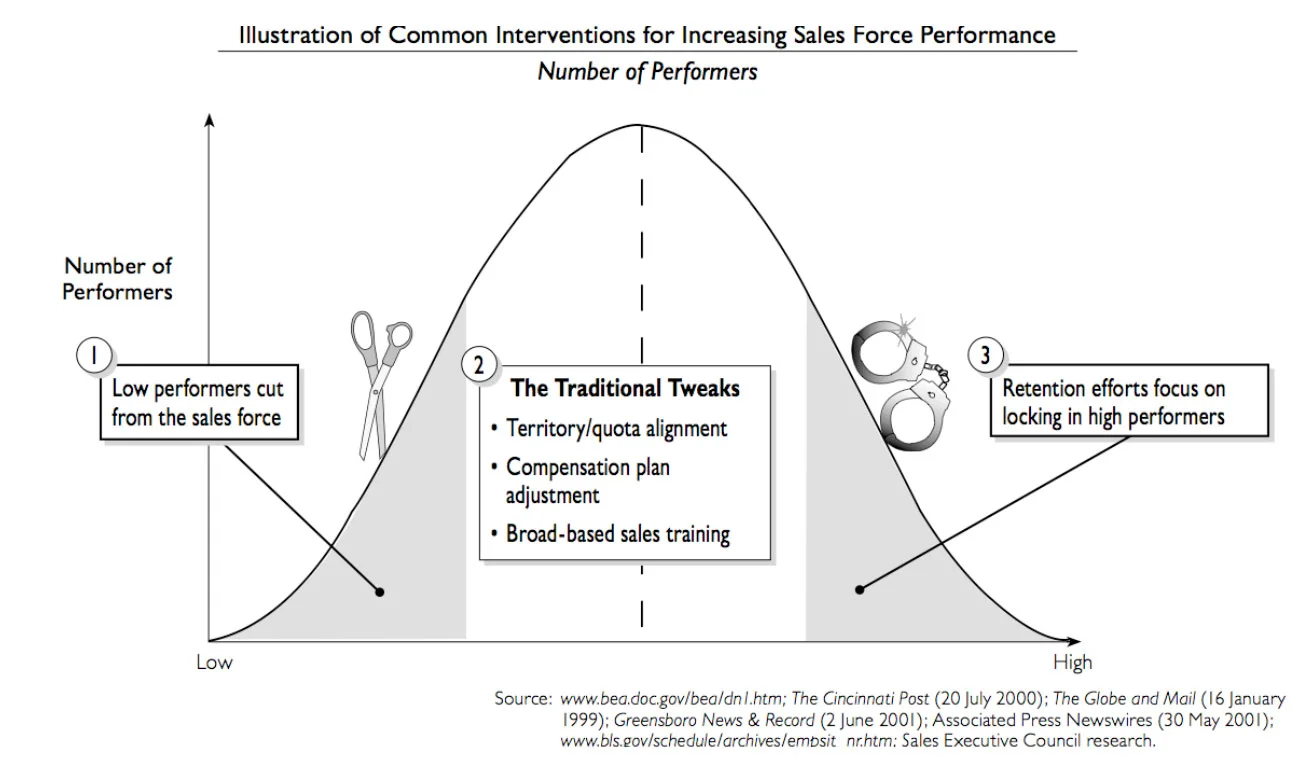
Some of the more traditional approaches to performance management and
retention are well articulated in this particular graph: “Illustration of
Common Interventions for Increasing Sales Force Performance.” The graph
illustrates the common company performance management “sandwich.” On the left
side is the bottom 10% that is normally actively managed up or managed out via
performance improvement plans. On the far right side is the top 10% with the
enhanced incentive plans to lock them in. In the middle is, well, the middle
with the usual question of what to do. A little more training? Perhaps a cost-
of-living increase?
Sticking With the Status Quo
According to a 2011 Society of Human Resources Management study, when
organizations were polled about their top talent development plans for 2012:
- 64% said they were going to invest in new career development opportunities;
- 43% said they were going to do market pay adjustments to ensure that the
top 10% knows they’re valued;
- 30% said they were going to do base pay increases and to make sure that
employees feel good at whatever salary rate they’re in and make sure that
they’re at the top of that range;
- 28% said they were going to increase non-cash recognition, which may
include training and other incentives; and
- 21% identified that they would provide larger bonus opportunities than
before.
What we see here of the five is that three are money-based as a way to get
people to stay, one is about career development, and the other one is about
non-cash recognition. The issue with this strategy is twofold. First, the
majority strategy as identified above with top talent is to throw more money
at them. What is missing, and what we know from Maslow’s hierarchy of needs,
is that once you hit a certain threshold with respect to having your basic
needs met it’s about professional development and self-actualization. At a
certain point, more money fails to drive performance. Second, focusing big
resources on the small segment of your top 10% will not maximize your employee
retention and development ROI.
Current Retention Strategies for Top Talent
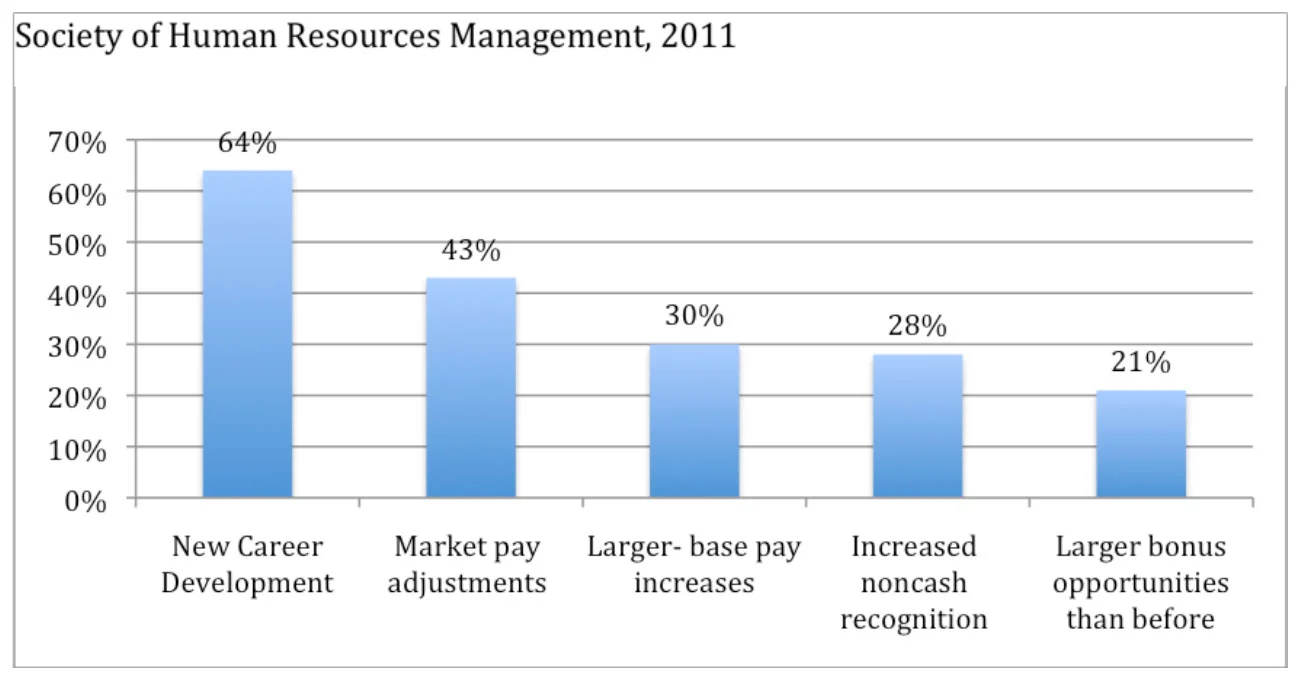
Research from the Sales Executive Council in their 2003 study looked at 625
sales reps and examined the traits and behaviors of the top 20%. It then
examined the “B” or middle level and identified if a company was able to
accelerate their growth if the company could move them into the top 10%.
Another way to think about this is that you’re investing in your top 10%,
which is fantastic, but what happens when they move on, are grabbed by another
company, or get promoted? Who’s after them from a talent pipeline perspective?
Investing in your middle 80% ensures you a pipeline of top performers, as well
as a performance gain.
When we look more closely, what the Sales Executive Council is saying is that
if your top 20% were able to increase their sales by 5%, you’re looking at a
$7.9 million increase. If you took your core 60% (which is, by the way, three
times more people) and you got them to increase their sales by 5%, you’d see a
$13 million difference. So just by sheer volume alone, when your middle 60%
are actually able to produce more, you see a 70% difference. Normally,
companies look to the top performers and ask them to produce more, instead of
looking at the middle and driving them to do more. See the chart below for
more details:
ROI – Details…
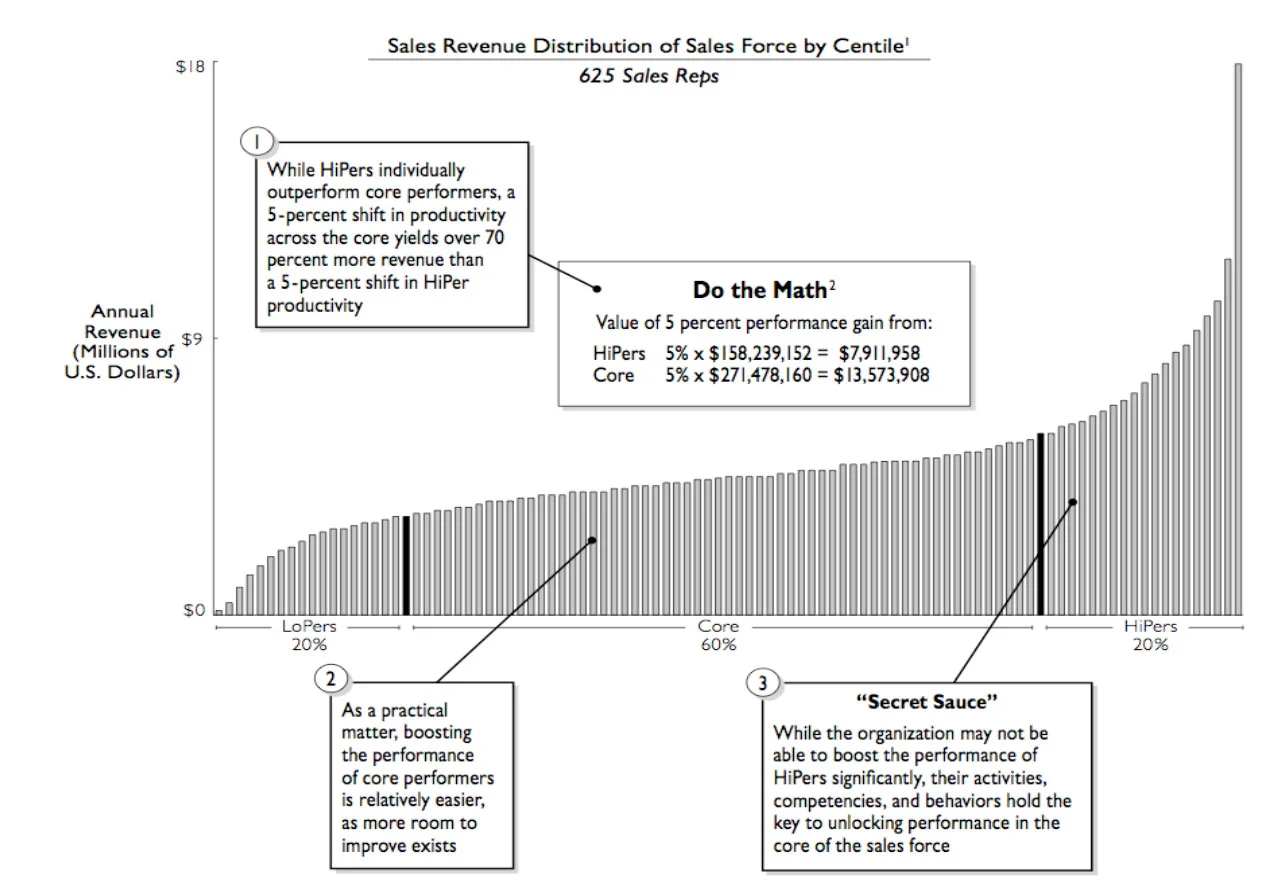
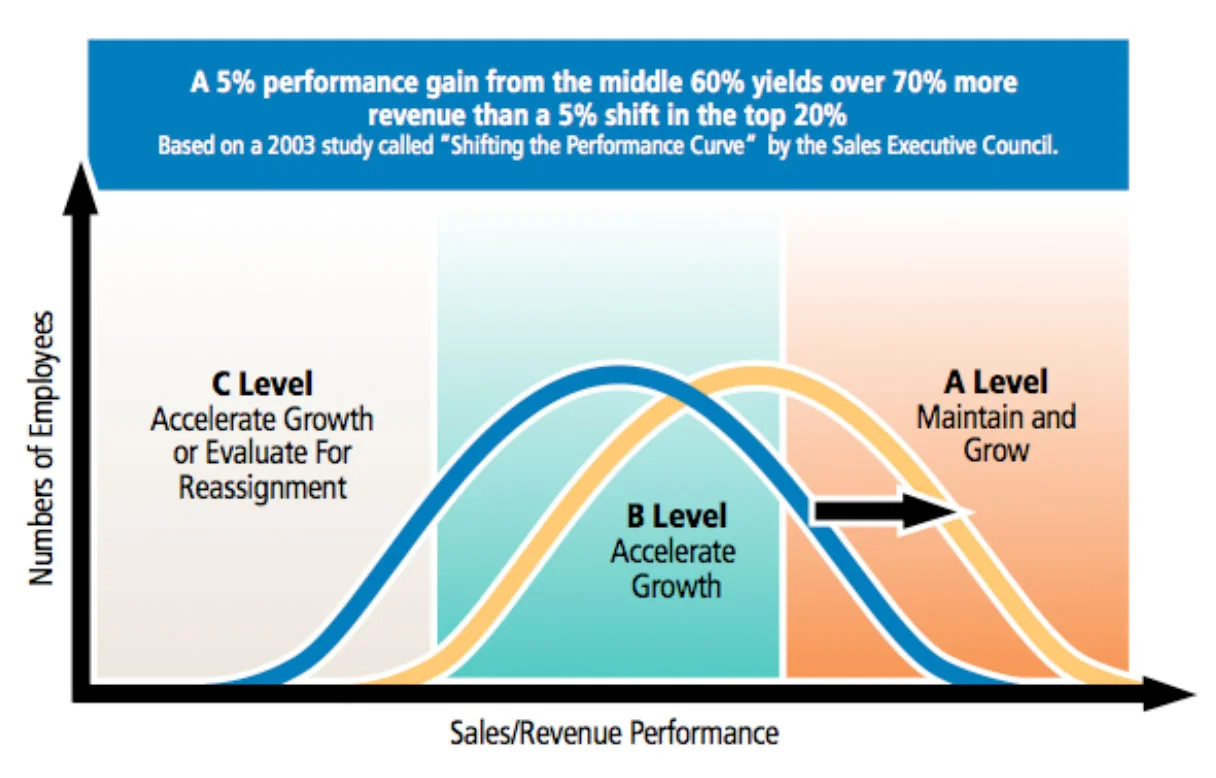
Maximizing the Middle through Individual Skill Development
When we go back to the Sales Executive Council study, one of the things we
notice is that as the level of the complexity of the job increases, you start
to see larger differences between top sales performers and your middle
performers. This variance is the result of differing skill competencies.
When the job gets more complex or demands are increased, sales employees are
not able to keep up. For middle performers whose skills and perspectives are
perhaps not as developed, there becomes a growing performance gap. See the
chart below for more details:
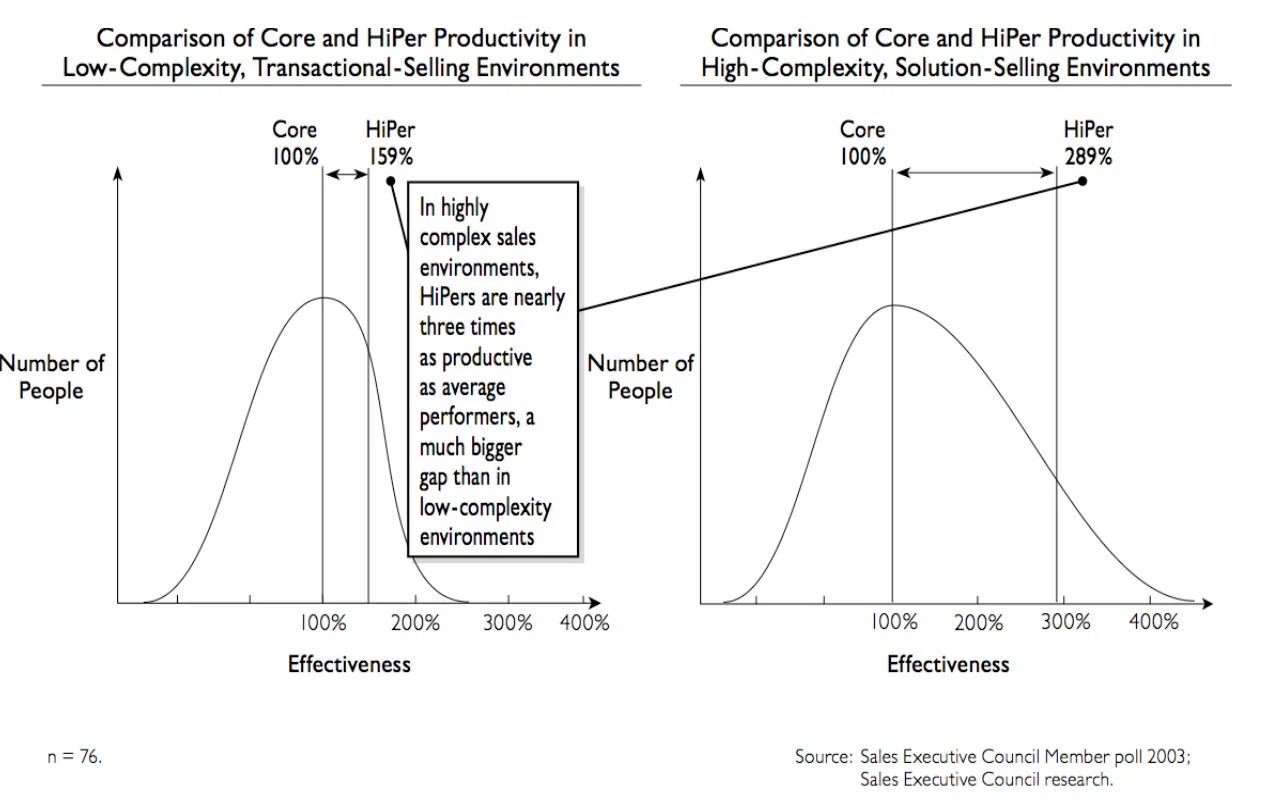
Sales Reps need the skills to quickly be perceived as credible and a match for
the executives to whom they are selling. An effective sales person needs to be
able to guide their client through the process of exploring, educating,
solving the problem, and closing the sale. The skills underlying the ability
to navigate complexity transcend traditional selling skills. Top sales
performers have high levels of communication, strategic thinking, emotional
awareness, resilience, and other skills traditionally identified as leadership
skills.
Strategies for Helping the Middle
Sales training tends to focus development on two ends of the spectrum: fix
what is wrong with a person (remedial models), or maximize and leverage what
is working well (strength-based models). Remedial models aren’t the best paths
because they focus on negative traits and tend to instill or reinforce a sense
of fear for one’s job or self-doubt. Strength-based models stroke the ego but
fail to stretch a person to grow and expand their capabilities.
To maximize your middle, you need to do something different.
Key Opportunities for Middle Skill Development
Maximizing your middle requires that you understand the skills that are most
relevant to leveraging your middle. These “middle” skills” are those that are
neither the strongest nor the weakest. Centering on the 1-3 mid-range skill
sets, you will provide the greatest return in terms of individual sales
performance and results. The rationale is that investing time and dollars into
the bottom of one’s skill repertoire will only gain slight improvement in
those skills. Investing the same dollars and time in your strongest skills
will also garner marginal improvement. Investing in your middle employees
garners the greatest potential performance ROI.
The typical middle skills that we’ve encountered among hundreds of individuals
can be organized into four categories:
1. Managing Self – The skill category of managing self centers on an
individual’s emotional intelligence, including his or her level and ability
for self-reflection, ability to understand how his or her actions or behaviors
or external emotions affect the people around them, and his or her ability to
learn and grow emotionally. When individuals are self-aware, they read
customers more effectively, adapt faster, build stronger credibility, and
exhibit emotional control. Managing self is critical to building trust and
credibility with a client.
2. Managing Others - The skill category of managing others centers on
the ability to effectively provide and receive feedback, resulting in clear
two-way communication and alignment with objectives with customers and with
coworkers. Effective delegation; ensures alignment of resources and the
ability to get work done, maximize resources, and align efforts to the right
priorities. Coaching skills; enable effective working relationships with
coworkers and customers, ability to ask the right questions, understand
challenges, issues and objectives, explore a range of solutions, and be seen
as a partner in the sales process, and build trust.
3. Leading The Sales Process - Sales people sometimes struggle with
leading the sales process and allow the customer to lead - that can result in
elongated sales processes or lost deals. The skill category of leading,
centers on the ability to think strategically about the issues facing the
customer. This category also includes innovation in order to creatively solve
problems, bring new ideas to customers, and break away from old ways of
thinking. In addition, this category includes the ability to effectively
communicate and inspire.
4. Execution - The skill of execution centers on the ability to
effectively plan, organize, and implement. The ability to effectively execute
is imperative to ensuring sales success, driving greater productivity, and
results.
Developing the skills of your middle can range from specific technical
training, to career mentoring, to leadership coaching.
Taking Action
Below are the steps that will help you begin the process of maximizing your
middle:
1. Identify your middle and the percentage of these employees in your
company. This will give you a clear picture of the scope of the opportunity.
2. Prioritize job families within your sales population. Some roles and
functions are more important than others at different times. Understanding
what your development priorities are will help ensure you are maximizing your
budget.
3. Review and confirm current performance programs that you have in place.
Identify if or how these program can be aligned to driving middle performance.
Identify what new programs will need to be deployed, the budget required, and
the timing.
4. Identify how success will be measured at a programmatic, cohort, and
individual level. If you are implementing large-scale coaching programs,
ensure that the programs can measure behavior improvement as well as broader
ROI.
Conclusion
Only 30% of 150 companies surveyed are taking the appropriate steps to
maximize their middle 80% of employees. Of these same companies, only 33% are
taking action to maximize their middle (as defined in this document). For any
sales organization looking for a way to drive sales productivity, improve
business results, and increase their competitive position, maximizing the
middle should become a priority.











